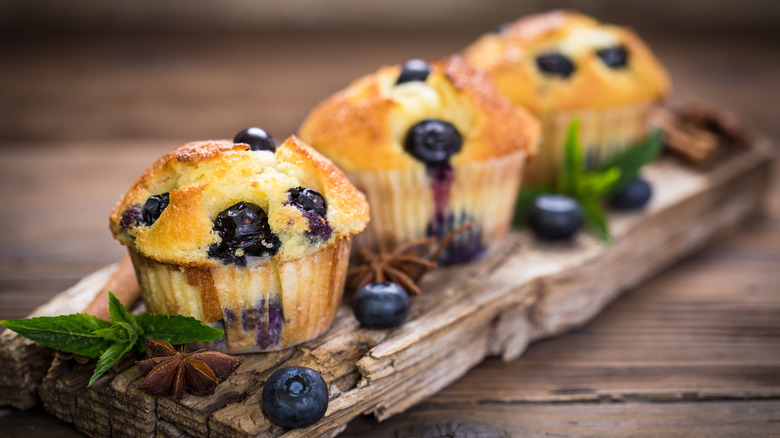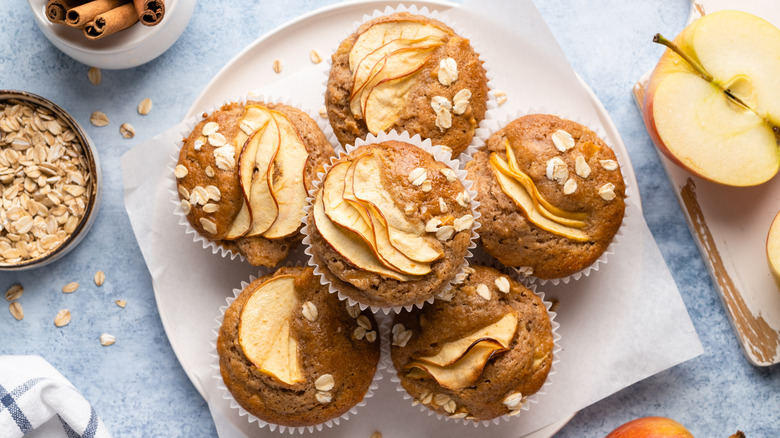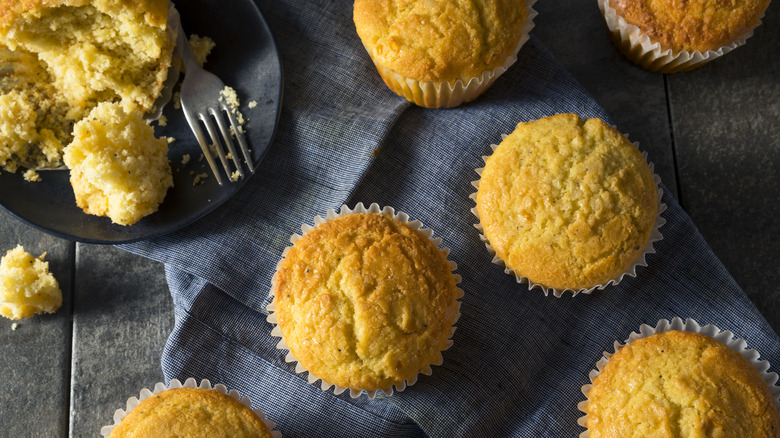How The American Muffin Has Morphed Over The Years
Do you know the muffin man? While the man in question may be fictional, the song that kicks off with those lyrics is quite real and dates back to 1820, according to the Museum of London. Along with providing a singalong video for the kids, the museum recounts a time when there may indeed have been a man who sold muffins on London's Drury Lane. Back in those Victorian times, the working class labored six days a week for 12 hours a day, leaving them little time to cook for themselves, let alone nice kitchens to cook in. So, buying food like baked potatoes, meat pies, and pea soup from street vendors was common practice. Muffins were no exception.
According to author and Boston University gastronomy professor, Megan J. Elias, muffins first emerged in that 19th-century English environment (via Thrillist). However, they point instead to the middle class, who had hired chefs that got up early to prepare time-and-labor-intensive breakfast dishes like muffins in the wee hours of the morning. So, is that where "English Muffins" come from?
Not quite. It turns out, Samuel Bath Thomas of Thomas' Breads came to the United States from England and then invented the "Nooks & Crannies" muffin stateside using a griddle baking technique. A bit later, Thomas opened a bakery in New York City and slowly but surely turned "English" muffins into an American classic. By that time, though, American muffins had already undergone a far more significant development.
Baking powder replaced yeast
We can't say for certain when precisely muffins first arrived in the United States. However, early 19th century cookbooks like "The Kentucky Housewife" from 1839 do mention muffin recipes (via Internet Archive). So, we know it must have happened around the same time the English were singing about the muffin man and enjoying his wares. During that time, per Thrillist, British muffins were raised by yeast. As such, it's safe to assume American ones were, too.
Smithsonian Magazine explains that, during the early history of American baking, this reliance on fickle yeast made cake-like desserts such as muffins a bit unpredictable. It took work to produce yeast via fermenting fruits or veggies, and then the weather or even bacteria could easily kill it before a baker even got started on the hours-long process of leavening. Thankfully, that all changed in 1856 when modern baking powder — the combination of acidic compound and baking soda salt to create carbon dioxide — made baking a relative breeze. Muffins benefited greatly, and the way was paved for 20th-century innovations like frozen and grab-and-go breakfast muffins. Nowadays, muffins are mass-produced and found everywhere.
3 states have official muffins
The muffin remains a popular breakfast and dessert. In fact, a trio of states has even made particular muffin types their official state muffins. According to State Symbols USA, Corn is Massachusetts', Apple is New York's, and Blueberry is Minnesota's.
In 1986, the corn muffin, a Massachusetts staple, was recognized. Yet, per the New York Times, it faced opposition from cranberry muffins. However, cranberry juice was already the state beverage. So, in the end, corn won out, all thanks to the efforts of some fourth graders.
In 1987, the apple muffin was recognized, further cementing apples as a part of New York's identity. After all, New York City is also called the "Big Apple," and apples had already been the state fruit for a decade at that point. When all was said and done, it was the "Apple Muffin Gang," a group of elementary school kids, who made this development happen.
In 1988, the blueberry muffin, based on Minnesota blueberries that grow wild in the state's bogs, was recognized. Massachusetts' corn muffin directly inspired the third graders who pushed for blueberry muffins (via Star Tribune). Some disagreed, and bran muffins were suggested instead, but bran has nothing on the sweetness of berries.
Whether from England or the United States, muffins are adored by Americans — muffin men, Kentucky housewives, and schoolchildren alike. Thankfully for home bakers, we've come a long from the yeast-risen muffins of old.


